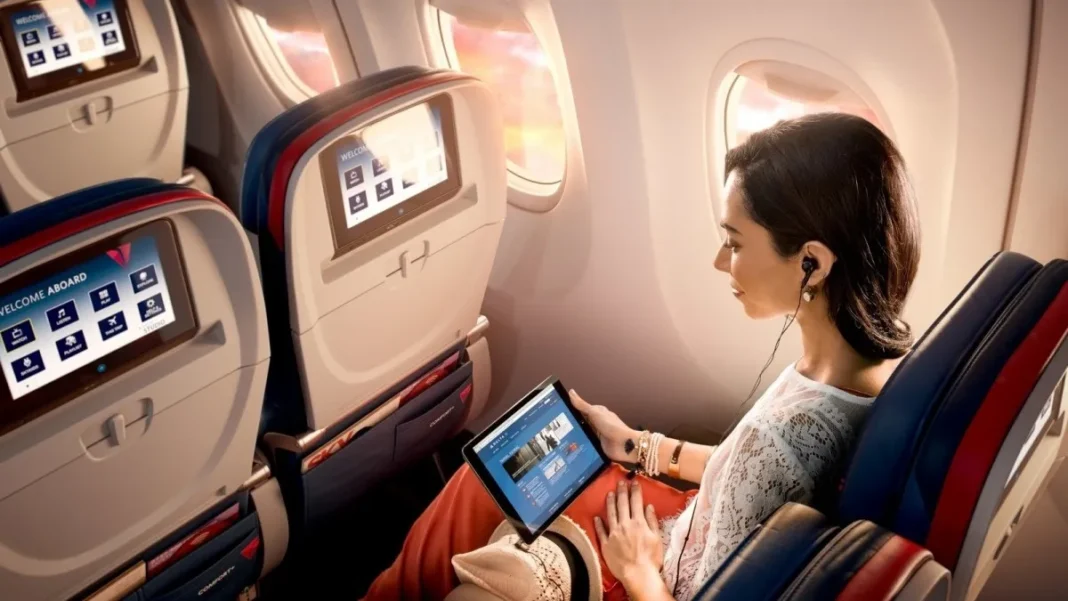|
Getting your Trinity Audio player ready...
|
Edited by: TJVNews.com
Ask any frequent traveler, and they will tell you that they have found themselves pondering the mysteries of in-flight Wi-Fi. How can it be that on one flight that they can binge Netflix without a hitch, yet on the very next trip, they struggle to send a simple two-word email? According to a recently published report in The Wall Street Journal, the answer, it turns out, lies in the outdated technology many airlines still use, but relief is on the way. Thanks to the latest satellite innovations, the future of in-flight Wi-Fi promises to revolutionize the experience. And based on recent testing, the improvements will be as fast as they are thrilling.
To understand the inconsistency of in-flight Wi-Fi, it helps to examine the current mishmash of technologies used by airlines. The short answer: it’s old. Really old. Some planes still rely on decades-old air-to-ground systems, while others have already upgraded to newer satellite technology. This leads to an unpredictable experience. The WSJ report indicated that on some flights, you’re surfing the web at decent speeds, while on others, you feel like you’ve been transported back to the early 2000s, struggling with connections slower than dial-up.
As part of a three-month investigation, Wall Street Journal columnist and prolific writer Joanna Stern, along with her colleagues from The Wall Street Journal, tested Wi-Fi on over 50 flights across eight different airlines. The results were as varied as they were revealing. Stern reported that in many cases, the type of aircraft and the technology it used determined whether she would have a smooth browsing experience or be left staring at buffering icons. The problem stems from the fact that airlines use a combination of air-to-ground (ATG) networks and satellite systems to provide internet access, as was noted in the WSJ report.
The great news? Airlines are now rolling out new satellite networks, and these promise to transform in-flight internet into an experience comparable to your home office connection—well, if your home office happened to be 35,000 feet in the air. As per the information provided in the WSJ report, among the leaders in this revolution are SpaceX’s Starlink and Intelsat, whose latest offerings provide speeds fast enough to handle streaming, video calls, and other bandwidth-hungry activities.
On several flights using these advanced satellite connections, the performance was astonishing. Stern reported that she was able to stream high-definition content, browse websites seamlessly, and even take part in a video conference—all while hurtling through the sky at 500 mph. The WSJ report said that these cutting-edge networks essentially eliminate the frustrations that travelers have long associated with in-flight Wi-Fi.
For example, Nikki Waller a colleague of Stern’s from The Wall Street Journal, boarded a Delta flight equipped with an older cellular-based connection and found that she could barely get any web pages to load, let alone perform the requested speed tests. Similarly, Jared Miller,(another colleague) on a United Airlines flight from Newark to Portland, Maine, struggled to even open his email, while Eric Bellman (another WSJ colleague) experienced painfully slow loading times on an Alaska Airlines flight from Oakland to Seattle, as was reported by Stern in the WSJ.
From barely functional email loading to unworkable streaming, travelers such as Nikki, Jared Miller, and Eric Bellman of the WSJ experienced firsthand the patchwork of outdated and underperforming technology still in use on many flights. According to the WSJ report, the reality of in-flight connectivity is far more complex than a simple on-or-off switch. It’s a technological jigsaw puzzle built from aging cellular networks, geostationary satellites, and various providers. And while change is on the horizon, passengers today are still subject to a frustratingly unpredictable experience when trying to stay online in the sky.
Many older jets, especially those flying shorter regional routes, still rely on air-to-ground antennas that connect to aging 3G cellular networks. This system, originally provided by Gogo (and later acquired by Intelsat in 2020), works by bouncing signals between the aircraft and cellular towers on the ground, the WSJ report explained. While it was revolutionary when first introduced, it’s no longer suited to the high-bandwidth demands of today’s travelers. And yet, there are still over 1,380 planes in the U.S. and Canada equipped with this outdated tech.
The problem with these air-to-ground systems is that they were designed for a different era—one where passengers weren’t trying to stream 4K Netflix shows or keep up with TikTok trends. The information contained in the WSJ report indicated that while this system was sufficient for sending emails or browsing the web at basic speeds, these connections struggle with anything beyond the most basic tasks, leading to frustration for anyone attempting to use them for more intensive purposes.
One of the most frustrating elements of in-flight Wi-Fi is the fact that travelers often end up paying for subpar service. On some flights, you could find yourself shelling out extra cash only to realize that the Wi-Fi barely functions. The report in the WSJ said that this is a direct result of the patchwork nature of the technology used on different planes. Older air-to-ground systems, for instance, are far less reliable than satellite-based systems, but both can come with a similar price tag.
Part of this inconsistency also stems from the fact that airlines often charge for access to in-flight Wi-Fi without clearly disclosing what kind of connection passengers will get. Without knowing whether you’re on a flight equipped with high-speed satellite service or a flight stuck in the technological dark ages, you might pay the same amount for dramatically different experiences.
Let’s start with the basics: why is in-flight Wi-Fi so inconsistent? The answer lies in how airlines acquire and upgrade their technology. The WSJ reported that according to Dave Bijur, senior vice president of commercial aviation at Intelsat, airlines decide what type of internet system to install when they purchase or reconfigure an aircraft. These choices can remain static for up to a decade due to the time and cost associated with taking planes out of service for upgrades. This strategy often leaves passengers stuck with outdated connectivity solutions for years.
All of these issues stem from older cellular-powered air-to-ground (ATG) networks, where planes use antennas to connect to cell towers on the ground. The WSJ report observed that while adequate for basic browsing a decade ago, these systems simply can’t keep up with the demands of modern internet use. The good news? Airlines such as Delta, United, and Alaska plan to phase out this outdated technology by the end of 2025, marking a shift toward faster, more reliable satellite-based internet.
Fortunately, the future is bright. The report in the WSJ indicated that SpaceX’s Starlink is already offering transformative connectivity on select flights, and other providers such as Intelsat are rapidly expanding their next-generation satellite networks. This is particularly exciting news for business travelers and families alike, whether you need reliable internet for work or just want to stream “Peppa Pig” to keep the kids entertained on long-haul flights, as was explained in the WSJ report.
The transition away from air-to-ground networks is already underway, with planes now turning their antennas skyward to tap into geostationary (GEO) satellites positioned over 20,000 miles above Earth, as per the information contained in the WSJ report. Many U.S. airlines use multiple internet providers across their fleets, including Intelsat, Viasat, and Panasonic, each employing different antennas, radio frequencies, and satellite systems. This diversity in technology can make for a wildly unpredictable experience, even within a single airline’s fleet.
But while the promise of GEO satellites was exciting, the real-world performance still leaves much to be desired. The report in the WSJ said that based on extensive tests conducted across multiple airlines, it’s clear that the type of satellite provider and specific technology installed on each plane heavily influences the quality of the connection. Even within the same airline, performance can vary significantly depending on the aircraft, the technology, and the satellite system in use.
On the test flights which relied mostly on GEO satellite connections, passengers could typically perform basic online tasks. The WSJ reported that around 70% of travelers could stream music, email, and load websites without issue. However, streaming video was far more problematic—only 40% of passengers managed to stream Netflix or similar video services. The issue wasn’t just about the technology but also about the sheer volume of users trying to access bandwidth-heavy services simultaneously. When too many passengers attempt to stream at once, the network speed takes a major hit, leaving everyone with slower and less reliable connections.
For example, Stern writes that United Airlines, where she is a frequent flier, currently offers streaming on about half of its mainline fleet. According to a United spokesperson, they plan to expand streaming capabilities soon, but for now, it’s a gamble as to whether you’ll get a flight equipped with a strong enough connection, the WSJ report said. Other airlines face similar challenges, balancing the need to upgrade their fleets while keeping planes in service and passengers connected.
It’s not just the tech providers that differ, but also the specific systems and frequencies that impact performance. Some satellites operate at higher frequencies, allowing for faster data transmission, while others use lower frequencies, which can handle more users but at slower speeds. Noted in the WSJ report was that this variability means that even if you’re on a flight equipped with satellite Wi-Fi, the experience might still fall short of your expectations, depending on the particular system in use.
While the geostationary (GEO) satellites currently used by many airlines offer decent connectivity, their inherent latency issues make certain online tasks, such as using Slack or Google Docs, difficult. The future of in-flight Wi-Fi lies in low-Earth orbit (LEO) satellites, and after testing these connections across several flights, the results are nothing short of transformative.




